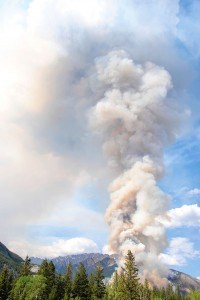
As more than 60 wildfires rage throughout the province, JasperÔÇÖs fire crew is busy mopping up after a long-awaited prescribed burn.
It was a burn eight years in the making, as Parks CanadaÔÇÖs fire crew waited for the perfect conditions to align, allowing it to burn 500 hectares of forest on the slopes of Mount Greenock.
Using aerial ignition, the Vine Creek fire unit went up in flames in no time.
From various vantage points throughout the park, it created an apocalyptic sight, as a huge mushroom cloud formed over the parkÔÇÖs eastern horizon. On social media, people posted photos of the smoke and joked that ÔÇťMount Jasper is erupting!ÔÇŁ
Although a startling visual, the good news is the fireÔÇöunlike the many others burning in the provinceÔÇöwill only have positive effects for the park.
The Vine Creek burn creates a fire break that could protect our neighbours from future wildfires and potentially stop the spread of mountain pine beetle by reducing viable habitat for the tree-killing insects.
And, ultimately, it will also help a species at risk: the whitebark pine.
Fire was a natural process on the landscape in Jasper National Park for centuries before it was actively suppressed after the parkÔÇÖs formation.
By reintroducing fire to the valley, it allows for new vegetation to grow and provides wildlife with a new food source, as well as new habitat.
For some, the idea of burning the parkÔÇÖs forests seems counterintuitive. We all learned in school that fire is bad. We learn from Smokey the Bear that ÔÇťOnly you can prevent wildfiresÔÇŁ and we were made to fear the repercussions of fire on the landscape.
But, as is clear with the Vine Creek burn and ParksÔÇÖ fire management program, there is a time and place for fire, and when itÔÇÖs well planned and articulated it can have positive results.
WeÔÇÖll see those positive results on Mount Greenock in the future, but unfortunately, they arenÔÇÖt likely for the rest of the province.
Our thoughts are with those Albertans whose communities are currently at risk because of unintentional wildfires started by lightning or careless campfires and our thanks go to ParksÔÇÖ fire crew for keeping our community safe during this dry, hot weather.
